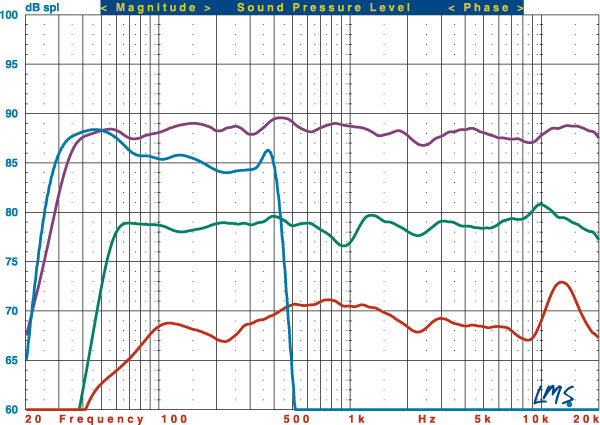It's about time we get a review of these Polks.. It seems the weakest link are the Subs, and I really think Polk should update their sub line to go beyond the DSWmicroPRO..
Good review and hope to see a review of the Bookshelf setup.
Polk LSiM707 Surround Speaker System HT Labs Measures
L/R Sensitivity: 88.5 dB from 500 Hz to 2 kHz
Center Sensitivity: 90 dB from 500 Hz to 2 kHz
Surround Sensitivity: 88.5 dB from 500 Hz to 2 kHz

This graph shows the quasi-anechoic (employing close-miking of all woofers) frequency response of the LSiM707 L/R (purple trace), DSW3000 subwoofer (blue trace), LSiM706c center channel (green trace), and LSiM702 F/X surround (red trace). All passive loudspeakers were measured with grilles at a distance of 1 meter with a 2.83-volt input and scaled for display purposes.
The LSiM707’s listening-window response (a five-point average of axial and +/–15-degree horizontal and vertical responses) measures +1.05/–1.73 decibels from 200 hertz to 10 kilohertz. The –3dB point is at 34 Hz, and the –6dB point is at 30 Hz. Impedance reaches a minimum of 3.75 ohms at 66 Hz and a phase angle of –47.96 degrees at 83 Hz.
The LSiM706c’s listening-window response measures +1.80/–2.42 dB from 200 Hz to 10 kHz. An average of axial and +/–15-degree horizontal responses measures +1.98/–2.60 dB from 200 Hz to 10 kHz. The –3dB point is at 55 Hz, and the –6dB point is at 51 Hz. Impedance reaches a minimum of 4.29 ohms at 8.6 kHz and a phase angle of –67.02 degrees at 84 Hz.
The LSiM702 F/X’s listening-window response measures +0.63/–3.60 dB from 200 Hz to 10 kHz. The –3dB point is at 89 Hz, and the –6dB point is at 65 Hz. Impedance reaches a minimum of 4.78 ohms at 6.6 kHz and a phase angle of –20.37 degrees at 3.3 kHz.
The DSW3000’s close-miked response, normalized to the level at 80 Hz, indicates that the lower –3dB point is at 27 Hz and the –6dB point is at 25 Hz. The upper –3dB point is at 415 Hz using the LFE input and default settings. —MJP
- Log in or register to post comments


It appears Mr. Norton has fallen victim to a common item of confusion with recent vintage Onkyo/Integra products. The 9.8 does not allow separate low pass and high pass frequencies as stated in the review. As can be seen on numerous HT forums, Onkyo/Integra's decision to expose the "LPF of the LFE" as a user adjustable option has lead many to believe as Mr. Norton that they can select the high and low pass frequency for bass redirection separately. In reality, the "LPF of LFE" setting only limits the high frequency response of the LFE (.1) channel in a multi-channel mix. The "LPF of the LFE" has no effect on information redirected from the main channels (L/C/R/Surrounds) to the subwoofer via bass management. Mr. Norton was sending only information below 40Hz in the main channels to the subwoofers while limiting information in the LFE channel to 80Hz and below. There was no overlap between the subwoofers and mains in the 40-80Hz range. In fact, if the sound mixer included >80Hz material in the LFE channel, that information was lost.
Mr. Norton's finding that mid-bass was thin when the mains were set to 80Hz is most likely a room placement issue where the room to listener relationship created a dip relative to the same frequency range produced by the mains. I know reviewers don't generally employ room correction during reviews, but it's likely the Audyssey MultEQ XT system in the 9.8 would have corrected the dip below 80Hz if the system were used with the 80Hz crossover on the mains instead of 40Hz.
As always, I enjoy Mr. Norton's audio reviews and look forward to more in the future. Don't limit him to video products only. :-)




































































